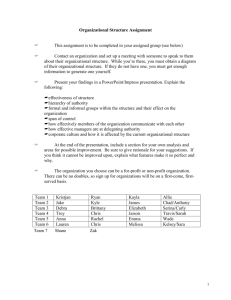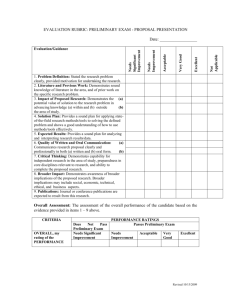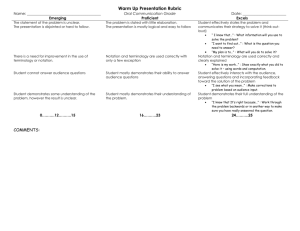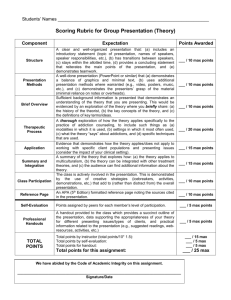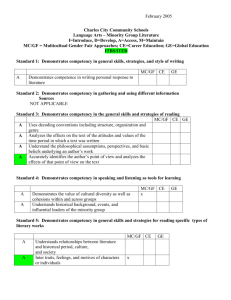Rubric - WordPress.com
advertisement
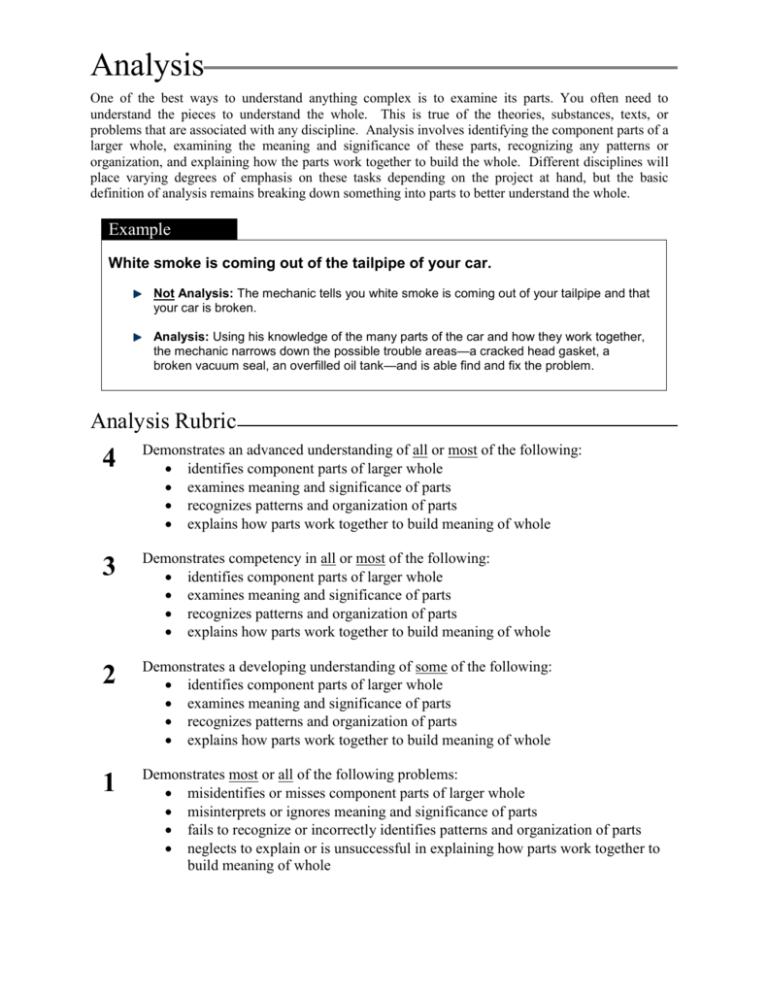
Analysis One of the best ways to understand anything complex is to examine its parts. You often need to understand the pieces to understand the whole. This is true of the theories, substances, texts, or problems that are associated with any discipline. Analysis involves identifying the component parts of a larger whole, examining the meaning and significance of these parts, recognizing any patterns or organization, and explaining how the parts work together to build the whole. Different disciplines will place varying degrees of emphasis on these tasks depending on the project at hand, but the basic definition of analysis remains breaking down something into parts to better understand the whole. Example White smoke is coming out of the tailpipe of your car. Not Analysis: The mechanic tells you white smoke is coming out of your tailpipe and that your car is broken. Analysis: Using his knowledge of the many parts of the car and how they work together, the mechanic narrows down the possible trouble areas—a cracked head gasket, a broken vacuum seal, an overfilled oil tank—and is able find and fix the problem. Analysis Rubric 4 Demonstrates an advanced understanding of all or most of the following: identifies component parts of larger whole examines meaning and significance of parts recognizes patterns and organization of parts explains how parts work together to build meaning of whole 3 Demonstrates competency in all or most of the following: identifies component parts of larger whole examines meaning and significance of parts recognizes patterns and organization of parts explains how parts work together to build meaning of whole 2 Demonstrates a developing understanding of some of the following: identifies component parts of larger whole examines meaning and significance of parts recognizes patterns and organization of parts explains how parts work together to build meaning of whole 1 Demonstrates most or all of the following problems: misidentifies or misses component parts of larger whole misinterprets or ignores meaning and significance of parts fails to recognize or incorrectly identifies patterns and organization of parts neglects to explain or is unsuccessful in explaining how parts work together to build meaning of whole Audience Before you begin to write, it is critical that you have a thorough understanding of who you are writing for. When you write for a class assignment, your professor is one of your audience members. However, you must master the skill of writing for a larger audience. To do this, you need to anticipate the expectations, needs, and objections of your audience and address each of these in your work. Keep your audience in mind as you write and revise. Ask yourself: What does my audience already know about the subject? What questions will they have? What will my audience object to? How will I respond to these objections without sounding like I am fawning over my audience or patronizing them? Audience considerations should guide many aspects of your writing, including organization, format, development, and tone. Example You are unhappy with a recent customer service experience involving your cell phone company. Audience not considered: You write a three-page letter to the Director of Customer Service. In it, you condemn the company, tell her she’s a lousy director, and ask her to fire her staff. Audience considered: You write a letter to the Director of Customer Service. Because she receives a lot of complaints, you keep your letter short, briefly detailing your issue and your attempts to resolve it. You include your full name and account number and underline your requested resolution. Audience Rubric 4 Demonstrates an advanced understanding of all or most of the following: Recognizes probable readers Considers the needs, expectations, and objections of readers Addresses appropriately the needs, expectations, and objections of readers Avoids patronizing or fawning tone 3 Demonstrates competency in all or most of the following: Recognizes probable readers Considers the needs, expectations, and objections of readers Addresses appropriately the needs, expectations, and objections of readers Avoids patronizing or fawning tone 2 Demonstrates a developing understanding of some of the following: Recognizes probable readers Considers the needs, expectations, and objections of readers Addresses appropriately the needs, expectations, and objections of readers Avoids patronizing or fawning tone 1 Demonstrates most or all of the following problems: Misidentifies or fails to consider probable readers Misunderstands the needs, expectations, and objections of readers Addresses inappropriately or ignores the needs, expectations, and objections of readers Uses patronizing or fawning tone Creativity Creativity is an especially difficult category to define. In popular culture, the term is applied to anything new or different, or having to do with self expression. While these uses of the term may be valid, they are so broad or vague that they make providing a useful definition difficult. A more focused definition is necessary here in that creativity is crucial to much academic work; innovation, problem solving, and discovery require you to move beyond standard ways of understanding the world. Essentially, creativity involves generating something original and useful, with emphasis on these elements varying widely depending on the discipline and project. You should first look for gaps in established approaches for addressing an issue, text, or case. Otherwise, your creative energy may be spent reinventing the wheel. While reinvention may be a worthwhile learning project, it can be a waste of time in some situations. Once you have an understanding of established approaches, you are more able to generate something truly unique. In many cases it is also important to provide questions or conclusions that demonstrate the value of your new idea. Example A team of designers is asked to create a new product for a cell phone company. Not Creative: The development team suggests adding bubblegum pink to the twenty other colors of the standard product. Creative: The development team suggests creating a phone that uses a touchscreen instead of buttons. Creativity Rubric 4 Demonstrates an advanced understanding of all or most of the following: Recognizes gaps in established approaches for addressing an issue, text, or case Offers a unique approach for addressing an issue, text, or case Provides useful questions or conclusions based on this approach 3 Demonstrates competency in all or most of the following: Recognizes gaps in established approaches for addressing an issue, text, or case Offers a unique approach for addressing an issue, text, or case Provides useful questions or conclusions based on this approach 2 Demonstrates a developing understanding of some of the following: Recognizes gaps in established approaches for addressing an issue, text, or case Offers a unique approach for addressing an issue, text, or case Provides useful questions or conclusions based on this approach 1 Demonstrates most or all of the following problems: Ignores or misunderstands established approaches for addressing an issue, text, or case Repeats established approach for addressing an issue, text, or case Provides questions or conclusions based on an established approach or fails to follow through on a unique approach Development A claim is only as strong as the evidence used to support it. Critical thinking generally goes beyond having the right answer or a good idea and requires the ability to fully explain how you came to a conclusion. This involves providing the appropriate and necessary amount of evidence to support your claims. Depending on the discipline and the project at hand, this evidence might include statistics, examples, logical proofs, quotations from relevant authorities, or study citations. For many projects, having the right evidence is still not enough. You need to logically explain why the evidence supports your claim. Example You hire a lawyer to defend you against jaywalking charges. Not Developed: In court your lawyer declares passionately that you are innocent. Developed: In court your lawyer calls witnesses and experts to the stand providing evidence about your case. She concludes with an explanation of how all of this information clearly demonstrates your innocence. Development Rubric 4 Demonstrates an advanced understanding of all or most of the following: Presents a clearly defined central position Provides the necessary amount of evidence to support claims Chooses the appropriate evidence to support claims Offers logical explanation of evidence 3 Demonstrates competency in all or most of the following: Presents a clearly defined central position Provides the necessary amount of evidence to support claims Chooses the appropriate evidence to support claims Offers logical explanation of evidence 2 Demonstrates a developing understanding of some of the following: Presents a clearly defined central position Provides the necessary amount of evidence to support claims Chooses the appropriate evidence to support claims Offers logical explanation of evidence 1 Demonstrates most or all of the following problems: Lacks or does not clearly define a central position Fails to provide enough evidence to support claims Chooses inappropriate or irrelevant evidence to support claims Offers illogical or no explanation of evidence Discipline-Based Writing A memo is not a research paper. A lab report is not a book review. These are obvious points, but until you fully understand the rules of a particular format, it’s nearly impossible to produce an acceptable document. Some of the differences are easy to spot just by glancing at the page. Are bullet points appropriate? Do bolded headings begin each section? Other differences are far more subtle. What form of citation is appropriate? Is it ok to use the passive voice? Every discipline has a particular format, style, terminology, and citation form. You learn to write within a discipline by looking at models or by being taught the expectations. Disciplinary writing is not intuitive; it is learned. But once you know the rules, writing within that field should become second nature. Example Your doctor writes you a prescription for codeine. Not Discipline-Based Writing: On notebook paper she writes a ten-page narrative essay about your skydiving accident. Discipline-Based Writing: On prescription paper she writes the type of drug and dosage, and signs her name. Discipline-Based Writing Rubric 4 Demonstrates an advanced understanding of all or most of the following: Maintains correct format Integrates and cites sources properly Follows discipline-appropriate writing style Uses disciplinary language skillfully 3 Demonstrates competency in all or most of the following: Maintains correct format Integrates and cites sources properly Follows discipline-appropriate writing style Uses disciplinary language skillfully 2 Demonstrates a developing understanding of some of the following: Maintains correct format Integrates and cites sources properly Follows discipline-appropriate writing style Uses disciplinary language skillfully 1 Demonstrates most or all of the following problems: Does not maintain format or incorporates format inconsistently Integrates or cites sources improperly Does not adhere to disciplinary writing style Misunderstands or misuses disciplinary language Interpretation To perform the task of interpretation, you must understand the basic meaning of the text, issue, or case you plan to interpret. Once you understand the literal meaning, you must draw from a relevant knowledge base—studies, research results, historical events, logic, or discipline-specific theories—to support your interpretation. The final step to interpretation requires you to come up with your own interpretive insights, drawing a conclusion from them that goes beyond the basic or literal meaning. Example During a snowstorm, you stop at the grocery store and witness an argument over the last loaf of bread. Not Interpretation: When you get home, you tell your family that you witnessed an argument over the last loaf of bread at the grocery store. Interpretation: Using your understanding of human behavior, you tell your family that you witnessed people acting out their anxiety over the impending snowstorm by fighting over the last loaf of bread. You conclude that resources need to be made available to calm the public during winter storms. Interpretation Rubric 4 Demonstrates an advanced understanding of all or most of the following: Understands the literal or basic meaning of the text, issue, or case Draws from a relevant knowledge base Provides conclusions that go beyond a literal or basic understanding 3 Demonstrates competency in all or most of the following: Understands the literal or basic meaning of the text, issue, or case Draws from a relevant knowledge base Provides conclusions that go beyond a literal or basic understanding 2 Demonstrates a developing understanding of some of the following: Understands the literal or basic meaning of the text, issue, or case Draws from a relevant knowledge base Provides conclusions that go beyond a literal or basic understanding 1 Demonstrates most or all of the following problems: Misunderstands the literal or basic meaning of the text, issue or case Draws from an irrelevant knowledge base Avoids conclusions or confuses a literal or basic understanding for interpretation Mechanics Many students fear writing because of what seems like a secret list of arbitrary rules that only their teachers have access to. Many of the rules governing writing do change over time and professors often do have their own particular pet peeves that they enforce. However, the vast majority of rules are there so we can understand one another with as little confusion as possible. Defining some of the categories that fall under mechanics is a good place to start dispelling some of the misunderstandings students have about writing. Grammar and syntax are the structural rules that govern a language, including the order of, form of, and relationship between words. Without these rules, we would not be able to put together words into meaningful sentences. Punctuation is the system of written marks, like periods and commas, used to clearly divide words into sentences, clauses, and phrases. When we speak, we provide pauses and emphasis to provide this clarity. Diction is the decision of what words to use. To clearly get our ideas across we need to not only consider the definition, but also the connotations that a word carries. If we use the wrong word, a vague word, or a word that carries an inappropriate tone, we are likely to confuse a reader. Writing allows you to communicate your ideas to the world. The rules governing writing allow you to be clear and concise. Example You apply for a job mentoring teenagers with drug problems. Your application letter begins: Bad Mechanics: I would be an excellent candidate for working with kids on drugs because I love them. Often having many emotional problems, I feel these teens are at risk for even more serious issues beyond addiction. Good Mechanics: I would be an excellent candidate for working with kids on drugs because I love kids. I feel these teens are at risk for even more serious issues beyond addiction because they often have many emotional problems. Mechanics Rubric 4 Demonstrates an advanced understanding of all or most of the following: Uses correct grammar and syntax Uses correct punctuation Uses correct, clear, and appropriate diction Writes so that mechanics do not hinder the reader 3 Demonstrates competency in all or most of the following: Uses correct grammar and syntax Uses correct punctuation Uses correct, clear, and appropriate diction Writes so that mechanics do not hinder the reader 2 Demonstrates a developing understanding of some of the following: Uses correct grammar and syntax Uses correct punctuation Uses correct, clear, and appropriate diction Writes so that mechanics do not hinder the reader 1 Demonstrates most or all of the following problems: Uses incorrect grammar and syntax Uses incorrect punctuation Uses incorrect, unclear, or inappropriate diction Writes so that mechanics hinder the reader Organization In order for your readers to understand the main point of your work, you must design an organization plan that presents a clear central position and then sequences main ideas and supporting information to support this main idea. For some writers, this organization plan takes the form of a written outline, developed before they begin to write. For others, an organization plan is developed after a first draft. Beyond an overall plan for content, successful organization also pays careful attention to smaller details, including transitions between paragraphs, sentences, and ideas that allow the reader to easily move from one supporting point to the next. Example You want to convince a friend to go on a backpacking trip through Europe Not Organized: You phone a friend, beginning your conversation by mentioning the weather in Europe. Next you tell her how fun backpacking is. Then, you jump to asking if she has $2000 saved up in the bank. Finally, you tell her about the trip to Europe. Organized: You phone your friend and clearly state that you’d like her to join you on a trip to Europe. You describe the joys of backpacking and tell her how much fun you had on a similar trip last year. Finally, you tell her how much the trip will cost and assure her that for a two-month trip, the $2000 is a reasonable fee. Organization Rubric 4 Demonstrates an advanced understanding of all or most of the following: Presents a clearly defined central position Sequences main ideas in a manner that effectively supports the central position Sequences supporting information to effectively support main ideas Uses effective transitions to connect ideas, sentences, and/or paragraphs 3 Demonstrates competency in all or most of the following: Presents a clearly defined central position Sequences main ideas in a manner that effectively supports the central position Sequences supporting information to effectively support main ideas Uses effective transitions to connect ideas, sentences, and/or paragraphs 2 1 Demonstrates a developing understanding of some of the following: Presents a clearly defined central position Sequences main ideas in a manner that effectively supports the central position Sequences supporting information to effectively support main ideas Uses effective transitions to connect ideas, sentences, and/or paragraphs Demonstrates most or all of the following problems: Lacks or does not clearly define a central position Sequences main ideas chaotically or in a way that ineffectively supports central position Sequences supporting information chaotically or in a way that ineffectively supports main ideas Lacks or unsuccessfully uses transitions to connect ideas, sentences, and/or paragraphs Research Not knowing information can get you into serious trouble. Consequences can range from buying a product at a bad price to getting into an unnecessary war. Finding good information can sometimes be as easy as asking a friend or doing an internet search for key words, but many situations call for far more difficult research. In academic work, research is crucial to better understand a subject, to provide authority to an argument, or to learn how another side views an issue. First and foremost you must be able to find appropriate sources for the project at hand. If the information you use is wrong or not suitable for your discipline you may be taking a step backward instead of forward. But research involves more than just deciding what information to use; you should also consider when, where, why, and how to use it. You must provide the right amount of information, efficiently and clearly integrate research into your work, and provide appropriate citation. Example Your car breaks down and you decide to purchase a used vehicle. Bad Research: You go to the nearest used car dealership and ask the salesman for the best deal on the lot. Good Research: You go online and look at several reputable and independent consumer sites to find the car that best fits your needs and budget. Research Rubric 4 Demonstrates an advanced understanding of all or most of the following: Chooses sources appropriate to the discipline and project Provides sufficient amount of research Integrates research efficiently and clearly into assignment Cites sources using appropriate documentation style 3 Demonstrates competency in all or most of the following: Chooses sources appropriate to the discipline and project Provides sufficient amount of research Integrates research efficiently and clearly into assignment Cites sources using appropriate documentation style 2 Demonstrates a developing understanding of some of the following: Chooses sources appropriate to the discipline and project Provides sufficient amount of research Integrates research efficiently and clearly into assignment Cites sources using appropriate documentation style 1 Demonstrates most or all of the following problems: Chooses unreliable sources or sources inappropriate to the discipline and project Provides insufficient amount of research Integrates research awkwardly or unclearly into assignment Cites incorrectly or uses inappropriate documentation style Summary The writer’s job when summarizing is to clearly identify the main ideas of a text, issue, or case and then provide supporting details that will help explain those main ideas. It is tempting to stray from the main point or include too much detail in your summary. However, you must stay focused on the source and its main points to provide a clear and concise summary of it. You also must represent the source fairly, remaining faithful to it. When you summarize, remember to avoid including your own personal interpretations. Summary should not be confused with the skills of analysis or interpretation. Summary does not require you to make judgments about the meaning and significance of the text, issue, or case. Nor does it involve coming up with conclusions about the value of your source. Example A friend asks you to tell him about a movie you saw last weekend. Not Summary: You tell him the movie was about a guy with superpowers. Then you tell him the rest of the movie was awful because the person sitting next to you wouldn’t stop talking. By the end of your summary, your friend has no idea what movie you saw. Summary: You tell him you saw Spiderman last weekend. You describe the characters and main scenes in the movie. Summary Rubric 4 3 2 1 Demonstrates an advanced understanding of all or most of the following: Clearly identifies main idea or ideas Provides adequate amount of supporting details Maintains judicious focus on source Remains arguably faithful to the text, issue, or case Demonstrates competency in all or most of the following: Clearly identifies main idea or ideas Provides adequate amount of supporting details Maintains judicious focus on source Remains arguably faithful to the text, issue, or case Demonstrates a developing understanding of some of the following: Clearly identifies main idea or ideas Provides adequate amount of supporting details Maintains judicious focus on source Remains arguably faithful to the text, issue, or case Demonstrates most or all of the following problems: Misidentifies or fails to present main idea or ideas Provides superfluous or inadequate amount of supporting details Loses focus by incorporating personal interpretation or outside information Misinterprets or misrepresents the text, issue, or case Synthesis Critical thinking often requires examining multiple texts, ideas, or objects together. This is particularly challenging because you must understand something in its own right before you can juxtapose it with something else. Synthesis can take many forms. You might be asked to compare and contrast three species of plants, place a text within the context of its historical/social period, combine two substances to create a new one, or apply an economic theory to a budget. All of these exercises are examples of synthesis in that you are being asked to make relevant connections between two are more things. Example You decide to make a cake for a friend’s birthday party. Not Synthesis: You place separate bowls of flour, sugar, milk, eggs, and baking powder on the table and tell everyone to enjoy. Synthesis: You find your mom’s recipe for birthday cake. You combine the ingredients, using the exact measurements and following the proper directions. Synthesis Rubric 4 Demonstrates an advanced understanding of all or most of the following: Chooses appropriate texts, ideas, or objects to examine together Demonstrates understanding of these texts, ideas, or objects Recognizes relevant connections Draws logical conclusions 3 Demonstrates competency in all or most of the following: Chooses appropriate texts, ideas, or objects to examine together Demonstrates understanding of these texts, ideas, or objects Recognizes relevant connections Draws logical conclusions 2 Demonstrates a developing understanding of some of the following: Chooses appropriate texts, ideas, or objects to examine together Demonstrates understanding of these texts, ideas, or objects Recognizes relevant connections Draws logical conclusions 1 Demonstrates most or all of the following problems: Chooses inappropriate texts, ideas, or objects to examine together Misunderstands or does not demonstrate understanding of these texts, ideas, or objects Fails to recognize or makes irrelevant or incorrect connections Fails to draw or draws inappropriate conclusions

